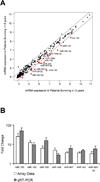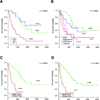Melanoma MicroRNA signature predicts post-recurrence survival
- PMID: 20179230
- PMCID: PMC4662869
- DOI: 10.1158/1078-0432.CCR-09-2721
Melanoma MicroRNA signature predicts post-recurrence survival
Abstract
Purpose: To identify a melanoma microRNA (miRNA) expression signature that is predictive of outcome and then evaluate its potential to improve risk stratification when added to the standard-of-care staging criteria.
Experimental design: Total RNA was extracted from 59 formalin-fixed paraffin-embedded melanoma metastases and hybridized to miRNA arrays containing 911 probes. We then correlated miRNA expression with post-recurrence survival and other clinicopathologic criteria.
Results: We identified a signature of 18 miRNAs whose overexpression was significantly correlated with longer survival, defined as more than 18 months post-recurrence survival. Subsequent cross-validation showed that a small subset of these miRNAs can predict post-recurrence survival in metastatic melanoma with an estimated accuracy of 80.2% (95% confidence interval, 79.8-80.6%). In contrast to standard-of-care staging criteria, a six-miRNA signature significantly stratified stage III patients into "better" and "worse" prognostic categories, and a multivariate Cox regression analysis revealed the signature to be an independent predictor of survival. Furthermore, we showed that most miRNAs from the signature also showed differential expression between patients with better and worse prognoses in the corresponding paired primary melanoma.
Conclusions: MiRNA signatures have potential as clinically relevant biomarkers of prognosis in metastatic melanoma. Our data suggest that molecularly based models of risk assessment can improve the standard staging criteria and support the incorporation of miRNAs into such models.
Figures



References
-
- Berger AJ, Camp RL, Divito KA, Kluger HM, Halaban R, Rimm DL. Automated quantitative analysis of HDM2 expression in malignant melanoma shows association with early-stage disease and improved outcome. Cancer Res. 2004;64:8767–8772. - PubMed
Publication types
MeSH terms
Substances
Grants and funding
LinkOut - more resources
Full Text Sources
Other Literature Sources
Medical

